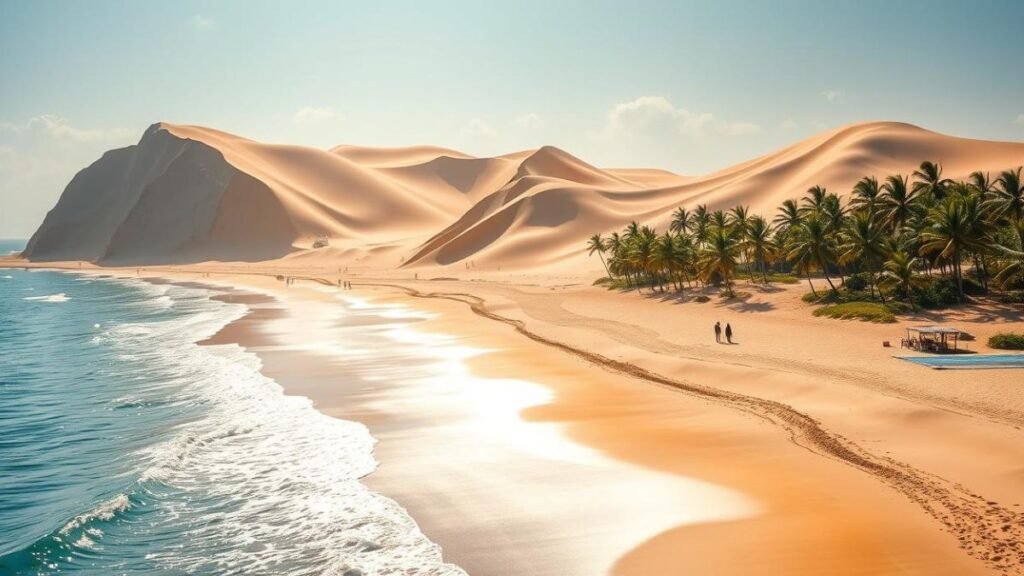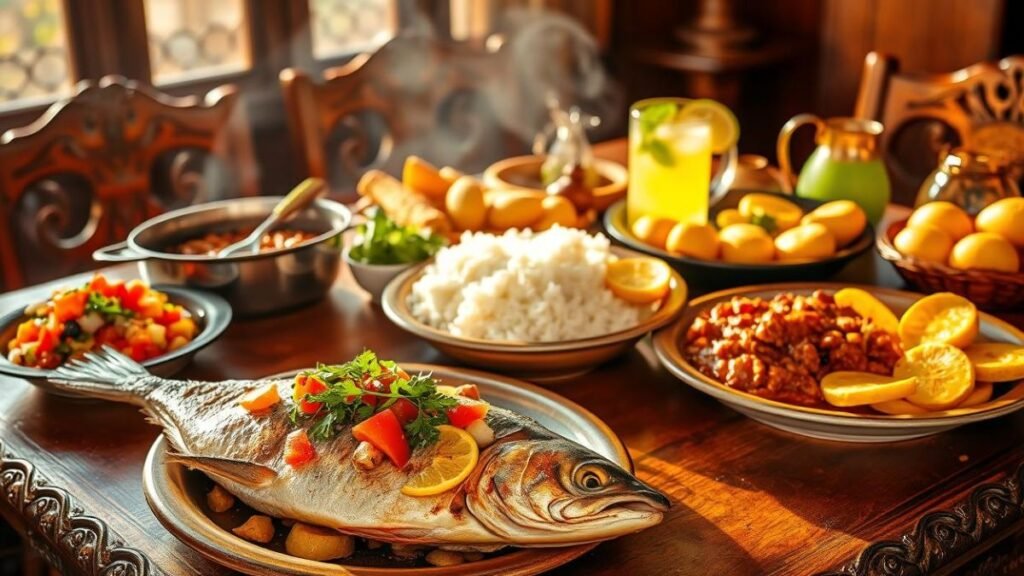Introduction
Ever wondered where golden sands meet thrilling outdoor adventures? Welcome to Natal Brazil, the vibrant coastal capital of Rio Grande do Norte, where towering dunes stretch as far as the eye can see. This sun-soaked paradise blends natural wonders with rich culture, making it a must-visit destination.
With its stunning beaches, inviting warm waters, and an array of outdoor activities, Natal offers a perfect escape for those seeking both relaxation and excitement. From exploring the majestic cliffs to engaging in water sports, every corner of this city invites adventure and discovery.

Known as the “City of Dunes,” this region boasts a unique landscape shaped by wind and waves, with its golden sands sculpted into towering formations that seem to dance in the sunlight. These majestic dunes are not only visually stunning but also offer a variety of activities that cater to thrill-seekers and nature enthusiasts alike. Its strategic location, situated near Africa and Europe, adds a fascinating historical twist, as it has been a crossroads of cultures and trade for centuries. Modern infrastructure, dating back to its World Cup 2014 hosting days, ensures comfort while exploring, with a range of accommodations and services designed to enhance the visitor experience.
From adrenaline-pumping buggy rides across shifting sands that provide breathtaking views of the coastline to uncovering hidden lagoons that sparkle like jewels amidst the dunes, every moment here is unforgettable. The contrast between the lush Atlantic Forest, rich in biodiversity, and the sweeping coastlines creates a playground for adventurers and nature lovers alike, offering opportunities for hiking, birdwatching, and immersing oneself in the local flora and fauna. Whether you’re seeking the thrill of sandboarding down steep slopes or simply wishing to relax by the tranquil waters, Natal presents a myriad of options that cater to all preferences.
Key Takeaways
- Discover breathtaking sand dunes stretching along the coastline
- Experience thrilling outdoor activities in a tropical setting
- Explore a unique blend of ecosystems from forests to beaches
- Learn about the area’s rich cultural and historical significance
- Enjoy modern amenities in a nature-focused destination
Introduction to Natal Brazil
Where endless sunshine meets rich history, this coastal capital of Rio Grande do Norte offers a one-of-a-kind escape. Founded on Christmas Day in 1599, the region blends tropical beauty with deep cultural roots, reflecting a vibrant tapestry of influences from indigenous peoples, Portuguese colonizers, and African heritage. Its strategic position—closest to Africa and Europe in all of South America—shaped its unique identity, making it a crucial point for trade and cultural exchange throughout history.
The city’s stunning beaches, lush landscapes, and historical landmarks draw visitors from around the globe, eager to experience the warm hospitality and rich traditions that define this enchanting destination.
Why This Destination Stands Out
With over 3,000 hours of sunshine per year, the area is a paradise for sun-seekers. The warm climate keeps temperatures between 75°F and 87°F year-round, creating an inviting atmosphere for outdoor activities and exploration.
Dry seasons from September to January make it ideal for tourism, as visitors flock to enjoy the pristine beaches and vibrant local culture during this period. The consistent weather allows for a variety of recreational opportunities, from beach sports to hiking in the nearby natural reserves.
Beyond beaches, the state boasts the world’s largest cashew tree—a Guinness record holder spanning 8,400 m², which is not only a natural wonder but also a symbol of the region’s agricultural richness. This remarkable tree draws tourists and botanists alike, showcasing the area’s unique flora.
Its economy thrives on petroleum, seafood exports, and tropical fruits, which contribute to a diverse culinary scene that reflects the blend of cultures in the region. For history buffs, the World War II-era Potenji Conference site adds intrigue, offering a glimpse into the city’s strategic importance during the war and its role in global history.
Geographical and Climate Highlights
The region features a rare tropical wet/dry climate, making it a unique destination for those interested in diverse ecosystems. June brings heavy rains (up to 13.7 inches), while other months stay comfortably dry, allowing for lush vegetation and vibrant landscapes.
The lush Atlantic Forest borders the coast, recognized by UNESCO for its biodiversity, and is home to countless species of plants and animals endemic to the area. This rich environment not only supports local wildlife but also provides opportunities for eco-tourism and educational experiences for visitors seeking to learn more about the region’s natural heritage.
| Season | Avg. Temperature | Key Feature |
|---|---|---|
| Dry (Sept-Jan) | 80.6°F | Perfect for outdoor activities |
| Wet (Feb-Aug) | 77°F | Lush landscapes, fewer crowds |
Greater Natal International Airport connects travelers globally. The city’s role during World War II as an Allied air base is explored in depth here. Dutch and Portuguese influences merge with indigenous traditions, seen in local crafts and festivals.
Exploring Natal’s Stunning Beaches
Stretching along the Atlantic coast, golden shorelines offer more than just sunbathing spots. Each beach here tells a different story—from lively urban strips bustling with energy and beachgoers to secluded surf havens that provide a peaceful retreat. Whether you seek adrenaline or relaxation, the area delivers unforgettable moments.
For those looking to engage in water sports, the waves at certain beaches are perfect for surfing, while others provide calm waters ideal for swimming and family outings. The vibrant beach culture is complemented by local vendors offering delicious snacks and refreshing drinks, creating an inviting atmosphere that beckons visitors to unwind and soak in the sun.

Ponta Negra Beach: The Heart of the Coast
Ponta Negra pulses with energy day and night, making it a vibrant hub for both locals and tourists. Its 4km stretch is framed by the iconic Morro do Careca cliff, a landmark that is not only visually stunning but also a popular spot for photographers. By day, kiosks serve fresh coconut water and local delicacies, inviting beachgoers to indulge in the flavors of the region; by night, live music fills the air, creating an electric atmosphere where people gather to dance and enjoy the warm tropical evenings.
“The sunset here paints the sky in hues you won’t forget,” says a local guide, emphasizing how the natural beauty of the beach transforms as the sun dips below the horizon, providing a perfect backdrop for romantic strolls or family gatherings.
Genipabu: Sand Dunes and Sunset Views
Mobile sand dunes tower 50 meters high, offering thrilling buggy rides that are a must for adventure seekers. These exhilarating rides allow visitors to navigate the undulating terrain, providing a rush of adrenaline as you speed across the sands.
Opt for a dromedary ride to glide smoothly down slopes, an experience that combines tradition with adventure. Time your visit for golden hour—the panoramic sea views are unmatched, as the setting sun casts a golden glow over the dunes, creating a picturesque scene that is perfect for photography enthusiasts and nature lovers alike.
Praia de Pirangi: A Surfer’s Paradise
Strong breaks attract surfers from all over, while the nearby 500 m-wide cashew tree, one of the largest in the world, lures agro-tourists eager to learn about local agriculture. Rent a board or join a farm tour—the beach seamlessly blends adventure with culture, allowing visitors to immerse themselves in the local lifestyle.
The surf culture here is vibrant, with surf schools offering lessons for both beginners and seasoned surfers, ensuring that everyone can enjoy the waves and the thrill of riding them.
Pro Tip: For snorkeling at Maracajaú’s tidal pools, aim for low tide. The crystal-clear waters reveal starfish and neon fish, earning it the nickname “Brazilian Caribbean.” This underwater paradise is perfect for both experienced snorkelers and families looking to explore the marine life together, making it a highlight of any visit to the area.
Delving into Natal’s Rich History
Step back in time to explore the layers of history that have shaped this coastal gem. The capital of Rio Grande do Norte has witnessed epic battles, economic booms, and cultural fusion, reflecting the diverse influences that have shaped its identity over the centuries. Each cobblestone and fortress wall tells a story of resilience, representing the struggles and triumphs of the people who have called this place home.
Forte dos Reis Magos: A 16th-Century Fortress
Built on January 6, 1598, the star-shaped Forte dos Reis Magos was strategically constructed to guard against invaders, serving as a crucial military outpost during its time. Its tidal defense system flooded moats at high tide, effectively trapping enemies who attempted to breach its walls.
“The Dutch called it New Amsterdam during their 1633–1654 occupation,” notes a local historian, highlighting the fortress’s role in the broader context of colonial power struggles. Today, visitors walk the ramparts, soaking in panoramic ocean views that offer a glimpse into the past while enjoying the beauty of the present.
Salt trade conflicts between Dutch and Portuguese forces left scars on the land and its people, marking a turbulent chapter in Natal’s history. The remnants of these conflicts are still visible, as the city has evolved, yet the spirit of resilience remains. Today, visitors walk the ramparts, soaking in panoramic ocean views, and are often captivated by the stories that echo through the fortress walls.
The Evolution from Colonial Settlement to Modern City
From cattle jerky (carne seca) to petroleum, the economy underwent a radical transformation over the years, adapting to the changing tides of history. The 1943 Potenji Conference, between Roosevelt and Vargas, cemented its role as a key strategic point in WWII, making it a focal point for military operations in the region.
The ruins of Parnamirim Air Base still whisper wartime secrets, serving as a poignant reminder of the city’s significant contributions during a critical period in history.
| Era | Key Industry | Legacy |
|---|---|---|
| Colonial (1599–1822) | Salt (40% of Brazil’s output) | Forte dos Reis Magos |
| Dutch Occupation (1633–1654) | Sugar | Architectural blends |
| Modern (20th–21st c.) | Petroleum/Tourism | Parnamirim Air Base |
In the Ribeira district, pastel-colored colonial houses now host cafes. Museu Câmara Cascudo showcases indigenous pottery and tools. The state’s heritage is alive in every corner.
Savoring Natal’s Unique Cuisine
A culinary journey here reveals bold flavors shaped by centuries of cultural exchange. The dishes of the Rio Grande region reflect Portuguese techniques, African spices, and indigenous ingredients, creating a rich tapestry of flavors that tells the story of its diverse heritage. Every meal becomes a vibrant event celebrating this fusion, where the freshness of local seafood meets the warmth of spices brought by African ancestors.
Diners can expect to savor traditional meals that not only delight the palate but also connect them to the region’s history and the people who have shaped it.

Street food stalls and upscale restaurants alike showcase the area’s creativity, reflecting a blend of traditions that span generations. The vibrant atmosphere of these food venues invites locals and tourists alike to indulge in culinary delights that are as rich in history as they are in flavor. Don’t miss Mercado Central—its 150+ vendors offer authentic tastes of daily life, featuring everything from freshly caught seafood to artisanal sweets that evoke nostalgia.
“Our recipes carry stories from three continents,” shares a local chef, emphasizing the cultural fusion that defines the region’s cuisine and the importance of food as a narrative of heritage.
Coastal Flavors: Carangueijo and Acarajé
Spicy carangueijo stew simmers with crab meat and coconut milk, creating a dish that is both comforting and exhilarating. Pair it with caipirinhas for balance, as the refreshing citrus notes complement the richness of the stew. For breakfast, try acarajé—black-eyed pea fritters stuffed with shrimp and chili paste. This dish has become synonymous with Brazilian street food culture and is often enjoyed on festive occasions.
These Afro-Brazilian staples trace back to Salvador’s culinary culture, where the influence of African heritage is palpable in every bite. Vegan versions now use hearts of palm instead of seafood, catering to diverse dietary preferences while maintaining the essence of the dish. Cooking classes teach the art of tempering dendê oil—a key ingredient—allowing participants to immerse themselves in the culinary traditions that have been passed down through generations.
Sweet Traditions: Tapioca and Cocada
Over 50 variations of tapioca crepes fill street carts, each offering a unique twist on this beloved staple. Try them with guava jam or savory cheese for a delightful contrast of flavors. Cocada, a 200-year-old coconut candy, comes in hues from white to caramel, showcasing the versatility of coconut in Brazilian desserts and the craftsmanship of local artisans.
| Dish | Key Ingredient | Best Paired With |
|---|---|---|
| Carangueijo | Fresh crab | Cachaça lime cocktails |
| Acarajé | Dendê oil | Spicy malagueta sauce |
| Tapioca | Cassava flour | Brazilian coffee |
During June festivals, look for canjica (corn pudding) and pamonha (sweet corn cakes), both traditional treats that bring families and friends together in celebration. These dishes, made from freshly harvested corn, are often enjoyed with a sprinkle of cinnamon or a drizzle of sweetened milk, enhancing their flavor and appeal.
The annual Natal Food Festival highlights seafood from the Rio Grande coast, showcasing the region’s rich maritime heritage and the abundance of fresh fish and shellfish that local fishermen bring to the markets. For history buffs, Casinha da Petúnia serves classics in a 1940s setting, where visitors can relish the nostalgic ambiance while savoring dishes that have been beloved for generations, making it a perfect spot to immerse oneself in the culinary history of the area.
Adventure Sports and Outdoor Activities
For thrill-seekers, this coastal region transforms into an adrenaline playground unlike any other. From towering dunes to vibrant reefs, the landscape offers endless excitement. Whether you crave speed or underwater exploration, these attractions deliver unforgettable experiences. Visitors can partake in guided tours that not only provide equipment but also share safety tips and local insights, ensuring that every adventure is both thrilling and safe.
Sandboarding on Genipabu’s Dunes
The 12km² dune field at Genipabu ranks among South America’s top adventure destinations. Compared to buggy rides, sandboarding offers more intense G-forces when carving down 50-meter slopes, making it a favorite for those seeking an adrenaline rush.
“Wax your board for maximum speed—the steepest drops hit 40mph,” advises a local guide, emphasizing the thrill of the descent. The dunes are not only a playground for adventure but also a stunning natural landscape that attracts photographers and nature lovers alike.
Beginners can practice on smaller inclines near the park entrance, where instructors are available to offer guidance and tips for mastering the basics.
Safety gear, such as knee pads and goggles, is mandatory—rentals average $30 per day, ensuring that everyone can enjoy the experience without worry. For variety, consider combining sessions with the Mandú Ecological Trail’s nearby canopy walks, where adventurers can explore the lush vegetation and observe local wildlife from a unique vantage point, adding another layer of excitement to their outdoor experience.
Diving and Snorkeling in Maracajaú
Seven miles of coral reef await at Maracajaú Marine Park, offering a vibrant underwater ecosystem teeming with life. The Pirangi Dive Center, renowned for its experienced instructors, offers PADI certification courses with an impressive 98% first-time pass rate, making it an ideal choice for both novices and seasoned divers. Night dives at Parrachos Reef reveal a magical world of octopuses and bioluminescent plankton, creating an unforgettable experience as divers witness the ocean come alive under the stars.
Snorkelers should target low tide for crystal-clear visibility, which allows for an unparalleled view of the underwater landscape. Over 270 fish species dart between brain corals in this protected area, including colorful parrotfish and graceful angelfish, making it a paradise for marine enthusiasts. Full equipment sets cost $50-$80, including waterproof cameras to capture the breathtaking moments, ensuring that visitors can document their adventures in this aquatic wonderland.
Snorkelers should target low tide for crystal-clear visibility, which allows for an unparalleled view of the underwater landscape. Over 270 fish species dart between brain corals in this protected area, including colorful parrotfish and graceful angelfish, making it a paradise for marine enthusiasts.
Full equipment sets cost $50-$80, including waterproof cameras to capture the breathtaking moments, ensuring that visitors can document their adventures in this aquatic wonderland.
Kiteboarding at Praia do Forte
August to January brings perfect 22-knot winds to this kiteboarding hotspot, attracting thrill-seekers from around the globe. The beach is divided into zones marked by colored flags: green for learners and red for experts performing aerial tricks, ensuring safety and organization.
Barreira do Inferno—South America’s first rocket base—forms a dramatic backdrop, adding to the excitement of the sport as kiteboarders soar against this iconic landscape.
| Activity | Skill Level | Avg. Cost |
|---|---|---|
| Sandboarding | Beginner-Friendly | $30-$45 |
| Scuba Diving | Certification Required | $65-$80 |
| Kiteboarding | Intermediate+ | $70-$90 |
Local schools offer 3-hour introductory lessons, including safety briefings, to ensure participants are well-prepared for their adventures. After mastering the basics, challenge yourself by crossing the tidal flats at speeds over 35mph, feeling the adrenaline rush as you glide across the water’s surface, making for an exhilarating experience that will leave you craving more.
Conclusion
This vibrant city blends 400 years of history with modern comforts, creating unforgettable experiences for visitors. From tranquil beaches to heart-pumping sandboarding, the attractions cater to every traveler’s taste.
The upcoming Costa Norte Smart City project promises cutting-edge tourist facilities while preserving natural beauty. Sustainable initiatives protect dunes and reefs, ensuring that future generations can enjoy these natural wonders.
For the best experience, plan a 5-day trip between June and November. Direct flights from Miami and Lisbon make access easy. As locals say: “Quem vai a Natal, sempre volta”—proof this destination leaves a lasting mark.
Pack your sense of adventure and discover why this corner of the world continues to captivate visitors year after year. Learn more Recife Brazil.
FAQ
What makes the city of dunes a must-visit destination?
Known for its breathtaking sand formations, vibrant culture, and year-round warm climate, this coastal gem offers unforgettable adventures, from dune buggy rides to pristine beaches.
Which beach is best for first-time visitors?
Ponta Negra Beach stands out with its golden sands, lively atmosphere, and iconic Morro do Careca dune. It’s perfect for swimming, dining, and taking in the sunset views.
Are there historical landmarks worth exploring?
Yes! The 16th-century Forte dos Reis Magos showcases colonial architecture and offers panoramic views of the Potengi River and Atlantic Ocean.
What local dishes should I try?
Don’t miss carangueijo (crab stew) and acarajé (fried bean cakes). For dessert, savor tapioca crepes or coconut-based cocada sweets.
Where can I experience adventure sports?
Genipabu’s dunes are ideal for sandboarding, while Maracajaú’s reefs offer top-tier diving. Kiteboarding thrives at Praia do Forte.
When is the best time to visit?
The dry season (September–February) guarantees sunny skies, but even off-peak months boast warm temperatures and fewer crowds.
How do I get around the city?
Taxis, ride-sharing apps, and buses are widely available. For dunes and remote beaches, guided tours or rentals are recommended.
Is the region family-friendly?
Absolutely! Safe beaches, eco-parks like Dunas de Genipabu, and cultural festivals cater to all ages.




